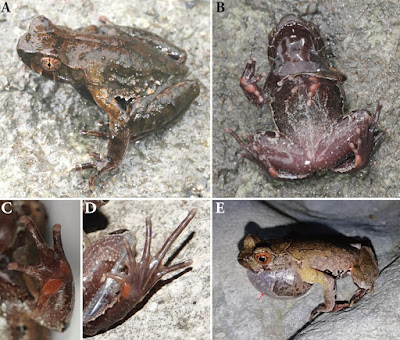 |
| Boulenophrys Wang, Wu, Peng, Shi, Lu & Wu. 2020 |
Abstract
A new species of the genus Megophrys from Zhejiang Province, China is described. Molecular phylogenetic analyses supported the new taxon as an independent clade nested into the Megophrys clade and sister to M. lishuiensis. The new species could be distinguished from its congeners by a combination of the following morphological characteristics: (1) small size (SVL 31.0–36.3 mm in male and 41.6 mm in female); (2) vomerine ridge present and vomerine teeth absent; (3) tongue not notched behind; (4) a small horn-like tubercle at the edge of each upper eyelid; (5) tympanum distinctly visible, rounded; (6) two metacarpal tubercles in hand; (7) relative finger lengths: II < I < IV < III; (8) toes with rudimentary webbing at bases; (9) heels overlapping when thighs are positioned at right angles to the body; (10) tibiotarsal articulation reaching tympanum to eye when leg stretched forward; (11) an internal single subgular vocal sac in male; (12) in breeding male, the nuptial pads with black nuptial spines on the dorsal bases of the first and second fingers.
Keywords: Taxonomy, new species, molecular phylogenetic analysis, morphology, Zhejiang Province, China
Megophrys xianjuensis sp. nov.
Diagnosis: Megophrys xianjuensis sp. nov. is assigned to the genus Megophrys based on molecular phylogenetic analyses and the following generic diagnostic characters: snout shield-like; projecting beyond the lower jaw; canthus rostralis distinct; chest gland small and round, closer to the axilla than to midventral line; femoral gland on rear of thigh; vertical pupils.
The new species could be identified from its congeners by a combination of the following morphological characters: (1) small size (SVL 31.0–36.3 mm in males and 41.6 mm in female); (2) vomerine ridge present and vomerine teeth absent; (3) tongue not notched behind; (4) a small horn-like tubercle at the edge of each upper eyelid; (5) tympanum distinctly visible, rounded; (6) two metacarpal tubercles in hand; (7) relative finger lengths: II < I < IV < III; (8) toes with rudimentary webbing at bases; (9) heels overlapping when thighs are positioned at right angles to the body; (10) tibiotarsal articulation reaching tympanum to eye when leg stretched forward; (11) an internal single subgular vocal sac in male; (12) in breeding male, the nuptial pads with black nuptial spines on the dorsal bases of the first and second fingers.
 |
| Habitats of Megophrys xianjuensis sp. nov. in the type locality, Xianju County, Zhejiang Province, China A landscape showing mountain forests B a mountain stream where toads of the new species occur. |
Distribution and habitats: Megophrys xianjuensis sp. nov. is known from the type locality, Xianju County, Zhejiang Province, China at elevations between 320–480 m a.s.l. This new species is frequently found on stones in the streams in the subtropical montane forests (Fig. 5E; Fig. 9). Six sympatric amphibian species, i.e., Amolops wuyiensis, Odorrana tianmuensis, O. graminea, O. tormota, Limnonectes fujianensis, and Quasipaa spinosa, were found.
Etymology: The specific epithet xianjuensis refers to Xianju County, Zhejiang Province, China, where the type locality of the species is located. We propose the common name “Xianju horned toad” in English and Xian ju Jiao Chan in Chinese.
Bin Wang, Yan-Qing Wu, Jun-Wei Peng, Sheng-Chao Shi, Ning-Ning Lu and Jun Wu. 2020. A New Megophrys Kuhl & Van Hasselt (Amphibia, Megophryidae) from southeastern China. ZooKeys. 904: 35-62. DOI: 10.3897/zookeys.904.47354




